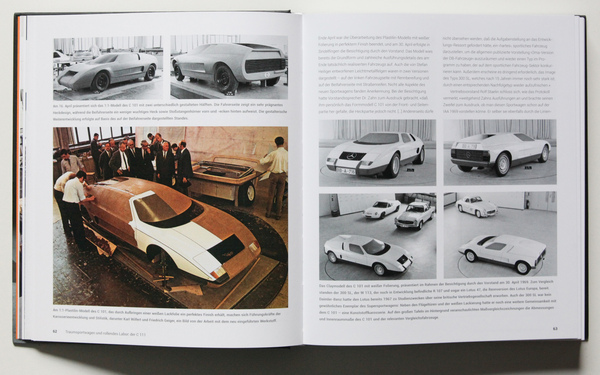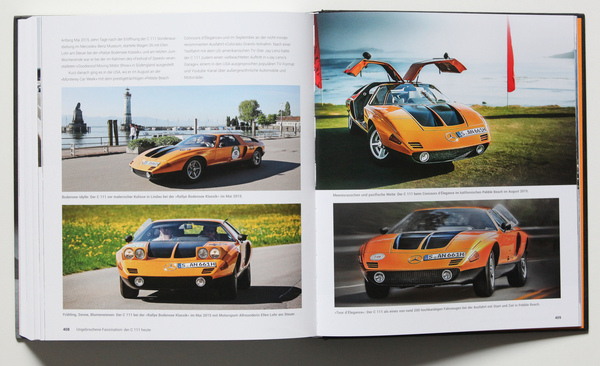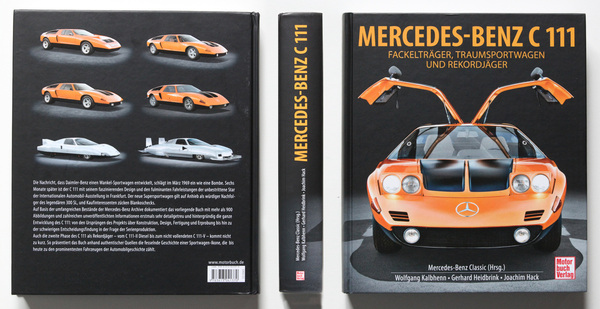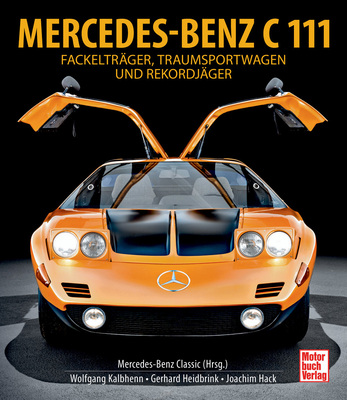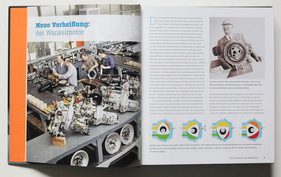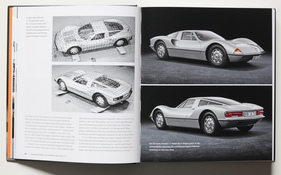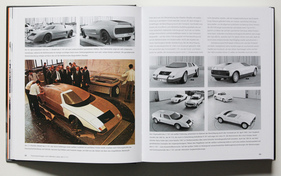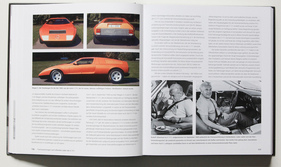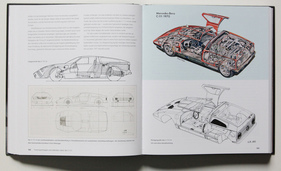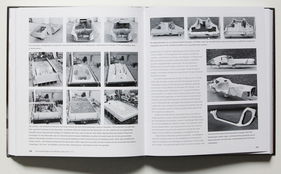Technical spearhead, 300-SL successor, dream car icon, trade fair star - the Mercedes-Benz C 111, first presented at the IAA in 1969, was only ever regarded as a rolling test laboratory in the in-house press canon, including for the Wankel engines developed in-house by Daimler-Benz. Even countless blank checks from interested customers could not persuade the Board of Management to launch series production of the mid-engined racer. The Mercedes Wankel engines were still far too unstable for that. The C 111 therefore always remained what it always was: a coveted prototype. The comprehensive history from the Wankel experiment to the diesel world record car is now the subject of a 400-page book.
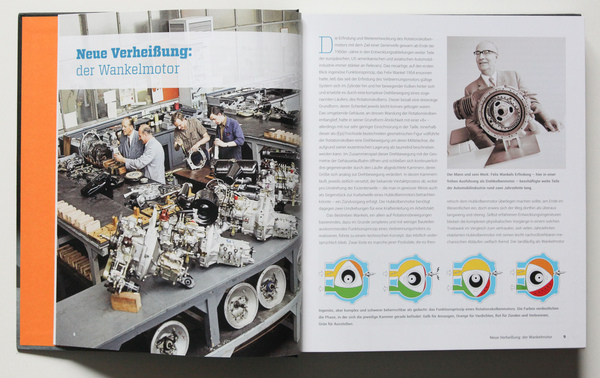
Mercedes in transition
Despite the tangible after-effects of the Second World War in West Germany, Mercedes-Benz succeeded in becoming one of the most innovative car manufacturers again in the 1950s. The victories of the 300 SL at Le Mans and the successful years in Formula 1 are just two examples of this. Just imagine: self-sufficient company management had only been possible again since 1949/50, and only a few years later the company was winning against the internationally established competition. With the 300 SL, a brand icon was launched, the export markets were conquered with a modern vehicle fleet and in 1963, the Mercedes-Benz 600, the state car par excellence, was presented in the showrooms of the major cities. All well and good, but not enough for the forward-looking sixties. While others were refining their brand image with lightweight construction, twelve-cylinder engines or sportiness, the brand with the star rested a little on its economic miracle laurels. The tail fins were never completely discarded; a 2.3-liter engine was suddenly enough for an SL. Somehow they had missed out on the further development of success. This lethargy took its toll on the many years of development and design lead times in automotive engineering and was reflected in the expression of the model range
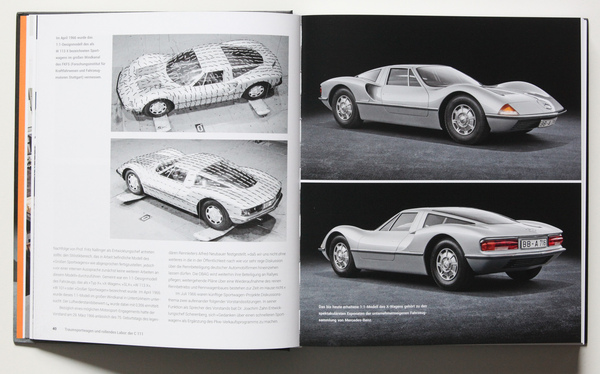
Behind the scenes
But Daimler-Benz would not be Daimler-Benz if there were not a reason for this: The company first had to find itself with its new role and then reinvent itself. From 1968 until the mid-1970s, the W 114/115, W 116 and W 107 series bore witness to the work behind the scenes. This also included the development of the Wankel engine. The company had acquired a license from NSU as early as 1961 and had already been working on its own developments. After all, the Wankel engine was seen as the future of engine construction. Mercedes also embarked on the long journey of developing its own generation of engines under Wolf-Dieter Bensinger, who had been a companion of Felix Wankel during the Second World War and had driven the Wankel theme forward. Optimistically, the W 116 and W 107 were already prepared for the series installation of both reciprocating piston and Wankel engines. However, it was never to come to series production of a Wankel engine at Mercedes-Benz. The roll-out of the C 111 prototype was the brief flare-up of an idea in which Mercedes-Benz assured itself and the world that it was prepared for the future
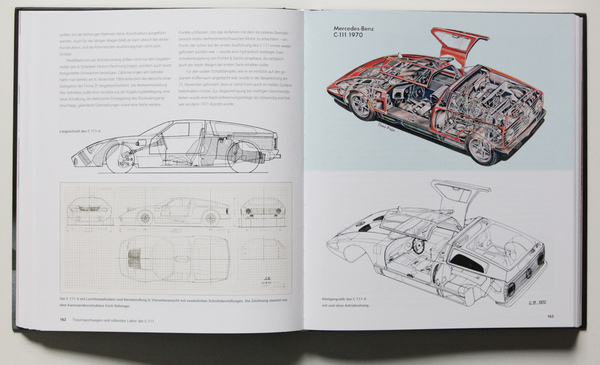
Super dream sports car
The origins of the C 111 lie at the beginning of the 1960s: sometimes a successor to the 300 SL was sought, then again sports cars with racing ambitions. Eventually, the mid-engine concept was chosen. At the same time, Wankel's in-house development department was also looking for a suitable vehicle design. At some point, this merged into the first ideas for a super sports car, which was intended to demonstrate what was technically feasible for the company. When it was unveiled at the IAA in 1969, the car hit like a bomb: the star of the Mercedes stand and, compared to the Mercedes-Benz series models, a vehicle from another planet. The Wankel enthusiasm had not yet been broken, and with its three and later four-disc Wankel engines of the type M 950 and M 951, the C 111 suddenly stood for sportiness with the prospective performance dimensions that would otherwise probably never have been available in Mercedes quality. The aforementioned blank checks prove the longing for this "dream car"

Much effort in vain in the end
The presentation of the C 111 was certainly courageous. After all, the car presented at the IAA in 1969 with a three-cylinder engine and the car presented in Geneva in 1970 with a four-cylinder engine - which had also been significantly redesigned - were miles away from series production. Particularly in terms of stability, the company suffered severe setbacks. The prospects of the Wankel engine for series production were never clear at Mercedes. The unsatisfactory durability was always at a comparable level to that of reciprocating piston engines. While Audi NSU had created a production and series production quality for the Ro-80 engine in 1972 in a major feat of engineering, Mercedes was plagued by setbacks such as water ingress into the chamber and rotor, punctured housings and engine failures after just a few hours of operation. Even after years of basic research, the sobering realization remained: persistent thermal problems could not be solved in the short term and a long service life was based on the principle of chance rather than a clear explanation. Not enough for series production at a car manufacturer committed to quality. The oil crisis in the fall of 1973 brought a swift end to the Wankel engine at Mercedes. Economical engines were now in demand. While Audi NSU once again set about developing the new EA 871 Wankel engine despite the same general conditions, which was able to keep up with comparable reciprocating piston engines in many areas when it was released for series production a few years later, the Daimler Board of Management cut expenditure on Wankel development by 75 percent. The future once again belonged to the reciprocating piston engine - not only at Mercedes - and in Stuttgart to the diesel engine in particular.
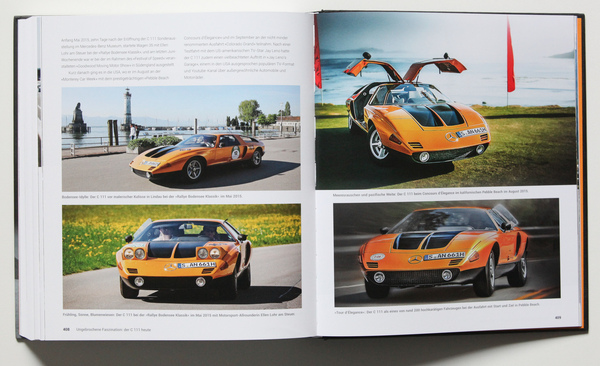
The second career
It was almost the end of the C 111. However, Mercedes-Benz wanted to demonstrate the performance of the diesel engine in a more spectacular way and set off on a record-breaking journey that attracted a lot of attention. What was missing was a suitable engine carrier. And so the C 111 was given a second career: the Wankel heart was ripped out and a five-cylinder turbodiesel engine with 190 hp was implanted. In the summer of 1976, the converted and slightly modified car broke all speed and acceleration records for diesel engines on the high-speed track in Nardó, Italy. A total of 16 records were smashed. But what a humiliation for the former innovation flagship: from a smooth-running, high-revving Wankel to a sluggishly glowing diesel. A few years later, an aerodynamically significantly revised version of the C 111 was launched on the high-speed hunt. In 1978, an average speed of 316 km/h was achieved. In a final expansion stage with a further aerodynamically optimized body, the C 111 with a twin-charged V8 engine reached the then absolute record speed for circuits of over 400 km/h. Then it was over. Then it was over. And that's where the book on the C 111 comes in.
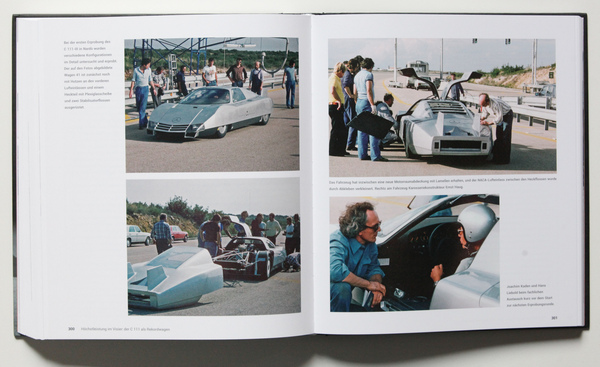
The book on the history
Never built in series but still a brand icon - the book on the C 111 was long overdue. More than 400 pages long, comprehensively illustrated with over 900 pictures, the author triumvirate of Wolfgang Kalbhenn, Gerhard Heidbrink and Joachim Hack have succeeded in presenting a wonderfully written book that impresses with its first-hand facts, thanks to meticulous research and meticulous searches among the protagonists of the time. At last you can find out the background to the development of the Wankel at Daimler-Benz and discover the motivation behind the construction and presentation of the C 111. All this in a neatly organized book that does not leave side lines to the core story unexplored. Despite the enormous density of images, it is not a "coffee table book" that puts a classy look and visual impressions before information. Thanks to the interviews with contemporary witnesses, the texts go into great depth, and the large number of historical (and in some cases previously unpublished) factory photos contribute to the high density of information.
In short: a book for absolute enthusiasts. Brief biographies of all the vehicles ever produced and their whereabouts are documented, as are abbreviations, engine code letters and a tabular list of the various C-111 test cars by chassis number. Many years after its active phase as a rolling laboratory and record chaser, the C 111 has lost none of its fascination and is still one of the most sought-after exhibits in the Mercedes-Benz Classic vehicle collection. Anyone who would now like to park their C 111 on the bookshelf can do so for €69.00. You won't miss a single drive in return.

Bibliographical details
- Title: Mercedes-Benz C 111 - torchbearer, dream sports car and record chaser
- Author: Wolfgang Kalbhenn, Gerhard Heidbrink, Joachim Hack
- Language: German
- Publisher: Motorbuch Verlag
- Edition: 1st edition October 2021
- Format: 230 x 265 mm
- Scope: 432 pages, 940 illustrations
- ISBN: 978-3-613-04137-0
- Price: EUR 69.00
- Buy/order: Online at amazon.com, online at Motorbuch Verlag or via the relevant bookstores



